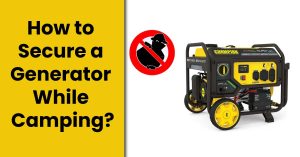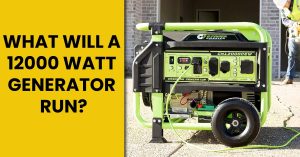How To Change Generator Spark Plug Safely? – Step By Step Guide
A well-maintained spark plug is essential to start a generator. If the spark plug is in bad condition, then it will create immense trouble for your machine by altering the overall performance of the engine. So, it is important to check as well as replace the spark plug on the generator every year to make sure the reliable starting and improved fuel economy.
It is also good to check the spark plug every season or every 25 hours of use to find out whether it is the right time for a replacement. Before moving towards performing maintenance of your generator, read the instructions mentioned in the manual or guide book for recommended maintenance and safety measures. These instructions vary from model to model and depending on your generator model, the instructions we are going to provide will also vary slightly.
In this article, we are going to help you by instructing you on how to change the generator spark plug. It is obvious that on some occasions while replacing the spark plug, you can cause great damage to the engine if the instructions provided to you aren’t followed properly. That is the reason you should realistically assess your skills. If at any point you feel like you won’t be able to complete all steps then it is highly recommended to spend some money to get aid from a professional for the replacement of your old spark plug.
What Does The Spark Plug Do?
Before learning about how to change a spark plug, you must know what does spark plug do. The answer is simple. When your engine cycles, a burst of electricity travels through the spark plug by creating a spark that jumps between the two electrodes at the end of the part. While inside its compressed environment, that spark plug ignites the gasoline mixed with air.
The result of a compressed and contained explosion causes the piston to drive away from the explosion inside the engine which moves everything else downstream in the chain of events.
When To Change A Generator Spark Plug
It is impossible to run the engine of your generator without a spark plug. If the spark plug is bad or isn’t working properly then the possibility of various engine problems will increase up to manyfold. Problems such as misfires, trouble initially starting the engine, rough idling, lack of acceleration even when your home appliances are calling for more power through the generator, and high fuel consumption.
These symptoms can indicate many other problems too. However, spending only a small amount of money on purchasing a spark plug will keep you safe from so much trouble. I’d highly suggest taking the initiative of this task as a troubleshooting method. Even if you go wrong at some point, it will not hurt anything.
All this process will take only 5 to 10 minutes without any complications.
Where Is The Spark Plug Located?
The location of a spark plug also varies from model to model. But if somehow you find the spark plug, you will experience the similarity in their appearance as well as in the process of changing them. In older or open-faced generators that do not have a protective wall covering, their spark plug will be easily accessible on one or the other side of the generator.
Most of the newer models of generators have a spark plug beneath a cover that is located at the top of the unit. While there are some models that have their plugs located underneath the sidewall and then below their own cover is held down by a screw. For this kind of generator, you will need a socket extension but you will also need a shorter one as the angle of the spark plug is in such a way that the sidewall will block anything longer than a few inches.
How To Change A Generator Spark Plug
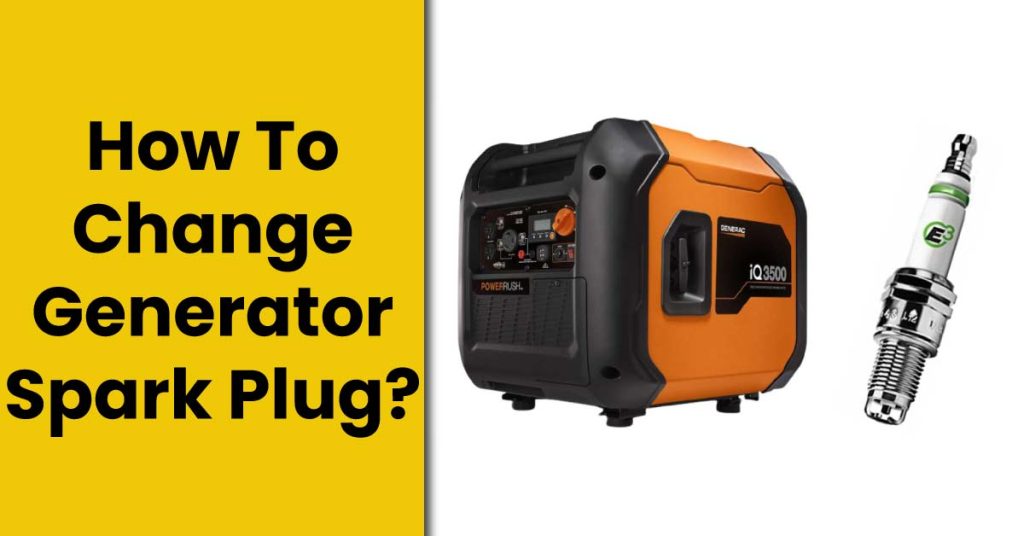
By changing the spark plug of your generator, the efficiency and lifespan of the engine will also increase. Below we have mentioned the complete step-by-step guide showing how to change the generator spark plug in a proper way:
Required Tools And Supplies:
Here are the following things you will need to collect while starting the process of changing the spark plug of your generator:
Remove The Existing Spark Plug:
The first and most essential step is to locate the spark plug and then remove it. This task can be a bit complicated for you if you are doing it for the first time. Usually, a spark plug is present beneath a removable casing and is covered by a spark plug boot.
Depending on our experience, one easy way to locate the spark plug is to find and follow a black cable that is connected to the engine and ends with a boot. If you are still facing a problem while locating the spark plug, you can check this out by the user’s manual.
The manual indicates where the spark plug is hidden and how to get the best access to it. There are some brands and powerful models that include more than one spark plug.
Due to this, you should always check the manual instructions provided with your generator.
Disconnect Plug Wire:
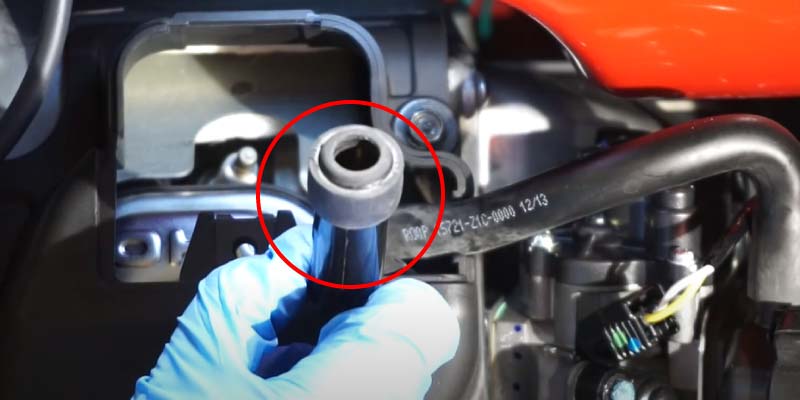
After finding the location of the old installed plug, you may now need to remove the wire that is already connected to it. To do it in a safe way, you will need to get access to the boot of the spark plug wire.
After getting the right access to it, grab onto the boot firmly, twist it in any direction and then pull it off at the same time. By doing so, you will easily break free the wire even if it is a little corroded. The rotatory motion helps to unclip the connection from the spark plug which will lower the strain on the wire.
It is not recommended to pull the wire portion as it will be damaged in that way very easily.
Clean Everything Around:
After unplugging the wire, now you need to make sure that the old plug and everything else around is clean. Take enough time to clean it off because if you neglect the cleaning process, your generator will definitely be damaged.
If you don’t know how to do this, we will help you to complete this task in the best possible way. When you are done removing the plug, you will have an opening directly into the engine. If something gets in its way, it will damage it sooner or later.
Make sure to remove and clean debris, dirt, or oil if there is any residue that could fall into it.
Remove The Old Plug:
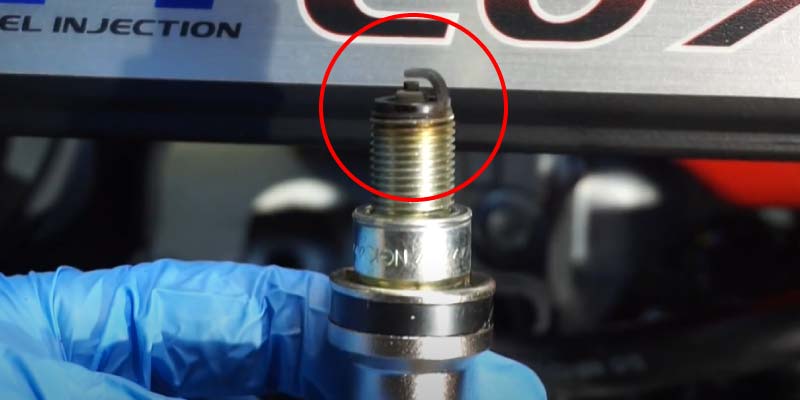
If the things are clean and you are sure that nothing could fall into the engine, then you may need to proceed to the removal of the old plug. For this, you will need a rachet or a correct spark plug socket. We’d suggest getting a 3/8 (14 mm) or 5/8 (16 mm) socket.
Also, go through the instructions manual provided with your generator. There will be some necessary information mentioned in it.
Once you find the correct socket, you may need to attach it to the spark plug manually. If it is perfectly seated on the spark plug, you can attach the ratchet and also an extension if needed.
We will recommend using a ratchet only to make the spark plug loose and then remove it. The rest of the unscrewing and threading should be done manually by turning the socket. While removing it, never change the angle of the socket as it will damage your plug.
Once it’s out, remove the plug from the socket to make a small room for the new one.
Check New Spark Plug:
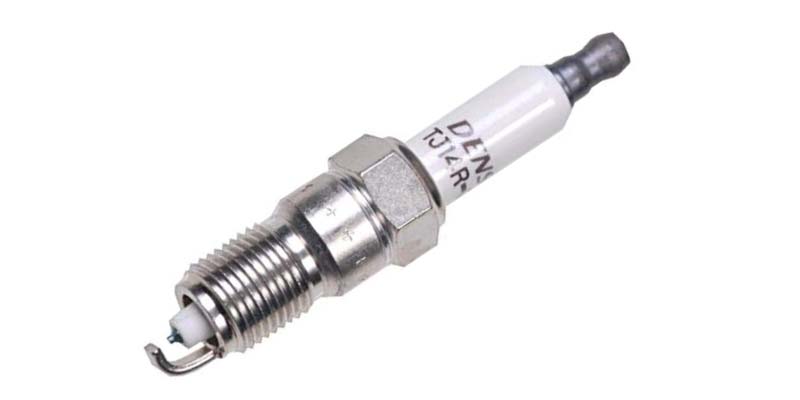
Before inserting the new spark plug into the generator, make sure that you have the correct model, size, and gap. I’d suggest using a gap-measuring tool for this purpose. This will not cost too much and no doubt it is very handy.
You can do this with the help of a feeler gauge by placing it into the gap until you move it around freely but start to feel a small amount of resistance. You should not keep it too loose or too tight.
After measuring this, you will need to compare it with one from the manual. If both are of the same number, then proceed to the further step. If you are unsure of getting the correct plug, take help from professionals at the local hardware store. This will help you in the best way.
Put In New Spark Plug:
If you are sure about the right gap you have got on the plug, you can install it now. Grab an empty spark plug socket, insert the new plug inside it, and then place it into the empty socket on your engine.
To make it sit on the hole properly, you can shake it a bit, and spin it gently with your hand. You have to do this smoothly without any resistance.
At this step, it is quite easier to cross-thread your plug and you need to be gentle while doing this. If somehow it gives any resistance, remove it and then try reinstalling it. If you experience no resistance at all, then keep it spinning manually until you reach a certain point where you cannot turn it anymore.
Attach a ratchet to the socket and tighten the spark plug. Be careful when doing this as you do not want to overdo it.
After tightening it, you can remove both your ratchet and spark plug socket.
Reconnect The Plug Wire:

After putting the new spark plug in its place safely, you need to reconnect the wire. Then grab the boot of the spark plug wire and slide it over the top of the plug. In the end, press it firmly until it goes all the way in.
Sometimes, you may feel or hear a click from the connector getting into the right position. Once the plug is reconnected, you can reattach the covers you had removed and now everything is good to go.
Note: It is highly recommended not to forget to “run a test” to find out if everything is working correctly.
Checkout our guide about how to change the generator rope.
How Often To Change Your Spark Plug?
Usually, spark plugs can last for several years. But this longevity depends on different factors. Some do not change it regularly and wait until one goes bad. However, it is well suggested to keep a spare spark plug for each engine to change immediately whenever the older one fails to work properly.
Keep that spare spark plug always with all of your other generator accessories.
I hope you don’t need to read another guide about How To Change the Generator Spark Plug. Please share it with your loved ones.

Alex Black is a seasoned electrical engineer with a remarkable 8-year track record specializing in appliances, generators, and transfer switches. With extensive hands-on experience in the field, Alex possesses a deep understanding of electrical systems and their intricate workings. Throughout their career, Alex has consistently demonstrated expertise in designing, troubleshooting, and maintaining various electrical appliances.

